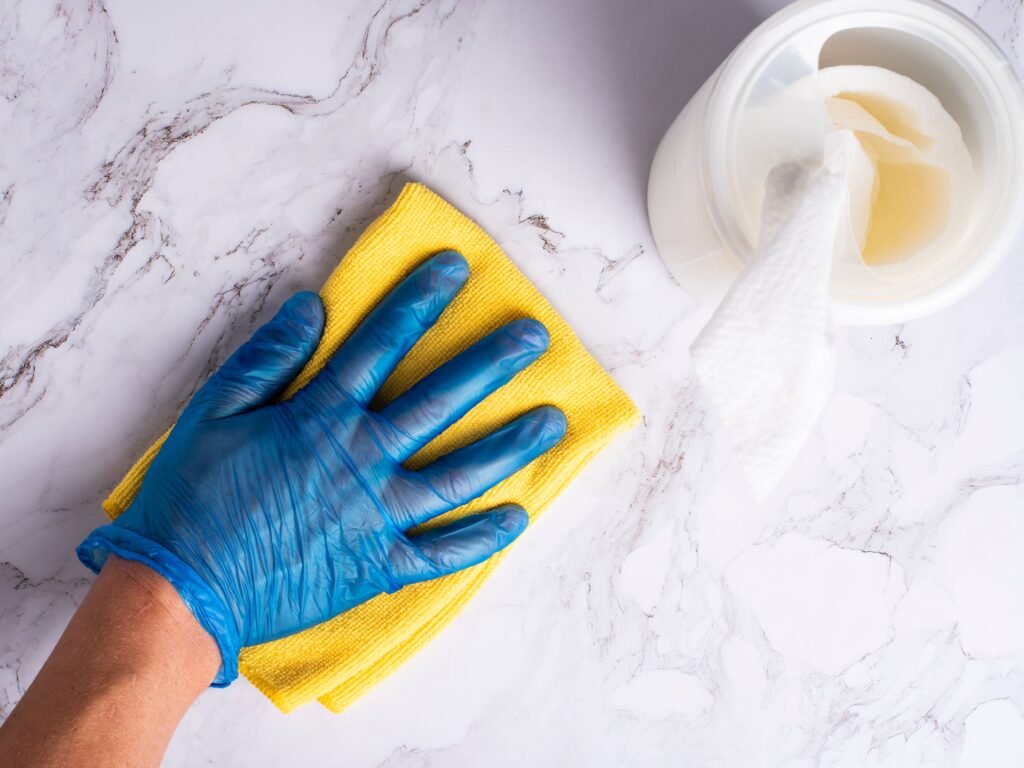So you’ve finally gotten yourself a shiny new firearm and you’re ready to hit the shooting range. But before you go loading up your magazine, there’s one crucial step you can’t afford to skip – cleaning your gun. Whether you’re a seasoned gun owner or a complete novice, this article is here to offer you the ultimate step-by-step guide to keeping your firearm in tip-top shape. From gathering the right tools to disassembling and cleaning each individual part, we’ve got you covered. So grab your cleaning kit, put on your favorite playlist, and let’s get started on a journey to a squeaky clean gun!

This image is property of images.pexels.com.
Gather the Necessary Supplies
Before you begin cleaning your gun, it’s important to gather all the necessary supplies. Here is a list of items you will need:
Safety goggles
Safety should always be a priority when dealing with firearms, so make sure to wear safety goggles to protect your eyes from any solvents or debris that may come in contact with them during the cleaning process.
Latex gloves
To protect your hands from any chemicals or oils, it’s a good idea to wear latex gloves. This will also help prevent any fingerprints or oils from transferring onto the gun during cleaning.
Gun cleaning solvent
A good gun cleaning solvent is essential for breaking down and removing fouling, residue, and debris from the gun’s internal parts. There are many options available, so choose one that is specifically formulated for firearms.
Gun oil
After cleaning your gun, you’ll want to lubricate it to ensure smooth operation and to protect against corrosion. Gun oil is specially formulated to provide the necessary lubrication and protection for firearms.
Bore brush
The bore brush is an essential tool for cleaning the barrel of your gun. It is designed to scrub away fouling and residue, ensuring that your gun’s barrel is clean and free from obstructions.
Cleaning patches
Cleaning patches are small pieces of cloth that are used to apply solvent and remove fouling and debris from the various parts of your gun. They can also be used to apply oil for lubrication.
Cleaning rod
The cleaning rod is a long, slender rod that is used to attach various cleaning tools, such as the bore brush or cleaning patches. It allows you to reach the different parts of your gun, ensuring a thorough cleaning.
Toothbrush
A toothbrush can come in handy for cleaning hard-to-reach areas or smaller components of your gun. It can be used to scrub away carbon buildup or residue from crevices and intricate parts.
Cotton swabs
Cotton swabs are useful for applying solvent to specific areas or for cleaning hard-to-reach places. They can be used to remove dirt, debris, or excess oil from small components of your gun.
Microfiber cloth
A microfiber cloth is ideal for drying and wiping down your gun. It is gentle on surfaces and helps remove any remaining residue or oils, leaving your firearm clean and ready for use.
Prepare a Safe and Well-Ventilated Area
Creating a safe and well-ventilated area before you start cleaning your gun is essential. Here are some steps to follow:
Choose a well-lit location
Pick a location with good lighting, as this will help you see any areas that need cleaning. Adequate lighting is also important for your safety as you handle and manipulate your gun.
Ensure proper ventilation
It’s important to clean your gun in a well-ventilated area to avoid inhaling any harmful fumes from the cleaning solvents. Open windows or use a fan to provide fresh air circulation while you work.
Clear any distractions or obstacles
Clear the area of any distractions or obstacles that could potentially interfere with your cleaning process. You want to be able to focus on the task at hand without any unnecessary interruptions.
Lay down a protective mat or cloth
To prevent any potential damage to your work surface, lay down a protective mat or cloth. This will catch any solvent drips or debris during the cleaning process, making for easier cleanup once you’re finished.
Unload Your Firearm and Confirm Its Safety
Before you start cleaning your gun, it’s crucial to ensure that it is unloaded and safe to handle. Here’s what you need to do:
Remove the magazine
First, remove the magazine from your firearm. This will eliminate the possibility of accidental discharge during the cleaning process.
Check the chamber
Once the magazine is removed, visually and physically check the chamber to ensure that there are no rounds present. Run your finger along the inside of the chamber to feel for any obstructions.
Eject any remaining rounds
If you find any rounds in the chamber, carefully and responsibly eject them by cycling the slide or bolt. Ensure that all ammunition is removed from the gun before proceeding with the cleaning process.
Keep the firearm pointed in a safe direction
Throughout the entire cleaning process, it is crucial to keep the muzzle of your gun pointed in a safe direction. Treat it as if it were loaded at all times, even if you have confirmed that it is unloaded.
Disassemble Your Firearm
To properly clean your gun, you will need to disassemble it. Here’s how you can do it:
Refer to the owner’s manual
Start by referring to the owner’s manual for your specific firearm. Each gun may have different disassembly procedures, so it’s important to follow the instructions provided by the manufacturer.
Follow the specific disassembly steps
Carefully follow the step-by-step disassembly instructions provided in the owner’s manual. Take your time and have a clear understanding of the process before proceeding.
Remove slide, barrel, and other parts
As you disassemble your gun, remove the slide, barrel, and other parts as instructed by the owner’s manual. Keep track of small components and ensure that you don’t lose any during the process.
Keep track of small components
As you disassemble your gun, you may come across small components such as springs, pins, or detents. It’s important to keep track of these parts and organize them in a way that makes reassembly easier.

This image is property of images.pexels.com.
Clean the Barrel and Bore
Cleaning the barrel and bore of your gun is essential for maintaining accuracy and preventing malfunctions. Here’s what you need to do:
Attach the bore brush to the cleaning rod
Attach the appropriate-sized bore brush to the cleaning rod. Make sure it is secure and will not come off during the cleaning process.
Apply gun cleaning solvent to the brush
Apply a small amount of gun cleaning solvent to the bore brush. This will help break down any fouling or residue inside the barrel.
Insert the brush into the barrel and scrub
Insert the bore brush into the barrel and scrub back and forth, applying moderate pressure. This motion will help remove fouling and debris from the barrel’s inner surface.
Repeat the process with cleaning patches
After scrubbing with the bore brush, attach a cleaning patch to the cleaning rod and saturate it with solvent. Insert the patch into the barrel and push it through, repeating the process until the patch comes out clean.
Inspect for cleanliness
Inspect the barrel for cleanliness by looking through it or shining a light to check for any remaining fouling or debris. If necessary, repeat the cleaning process until the barrel is thoroughly clean.
Clean the Slide and Frame
The slide and frame of your gun also require cleaning and maintenance. Follow these steps to ensure a thorough cleaning:
Apply gun cleaning solvent to a cleaning patch
Apply a small amount of gun cleaning solvent to a cleaning patch or cloth. This will help break down and remove any residue or fouling from the slide and frame.
Wipe down the slide and frame
Gently wipe down the slide and frame with the solvent-soaked cleaning patch. Pay special attention to areas that may have more debris or residue, such as the ejection port or slide rails.
Pay attention to hard-to-reach areas
Use a toothbrush or cotton swabs dipped in solvent to reach and clean hard-to-reach areas such as crevices or corners of the slide and frame.
Use a toothbrush or cotton swabs for details
For smaller details or intricate parts, use a toothbrush or cotton swabs to scrub away any remaining dirt or residue. These tools will help you reach areas that may be difficult to clean with larger cleaning patches.
Dry the surfaces with a microfiber cloth
After cleaning the slide and frame, use a dry microfiber cloth to wipe away any excess solvent and ensure that the surfaces are dry. This will prevent any potential water spots or damage to the finish.

This image is property of images.pexels.com.
Remove Carbon Buildup
Carbon buildup can occur in various parts of your gun, affecting its performance. Here’s how you can remove it:
Use a nylon brush for carbon removal
Select a nylon brush specifically designed for removing carbon buildup. This brush will be gentle enough to use on delicate parts while effectively removing stubborn carbon deposits.
Scrub the internal components
Using the nylon brush, scrub the internal components of your gun, such as the slide rails, barrel hood, or breech face. Pay attention to areas that tend to accumulate carbon buildup.
Remove carbon from small crevices
Carbon can also accumulate in small crevices or hard-to-reach areas. Use a toothbrush or cotton swab to clean these areas, ensuring that all carbon deposits are removed.
Inspect and repeat if necessary
After cleaning, carefully inspect the internal components for any remaining carbon buildup. If you still notice deposits, repeat the cleaning process until your gun is free from carbon.
Apply Lubrication
After thorough cleaning, it’s important to apply lubrication to ensure your gun functions properly and is protected against corrosion. Here’s what you need to do:
Apply gun oil to a cleaning patch
Apply a small amount of gun oil to a cleaning patch or cloth. The oil will act as a protective barrier and provide lubrication to the moving parts of your firearm.
Wipe down the slide, barrel, and frame
Gently wipe down the slide, barrel, and frame with the oil-soaked cleaning patch. Focus on friction points and areas that require lubrication, ensuring that all metal surfaces are covered.
Focus on friction points and moving parts
Pay extra attention to the friction points and moving parts of your gun, such as the slide rails, trigger mechanism, or barrel hood. These areas require sufficient lubrication for smooth operation.
Ensure a thin and even coat of oil
When applying the oil, ensure that it is spread evenly across the surfaces, forming a thin coat. Avoid applying excessive amounts of oil, as this may attract dirt or debris over time.
Remove excess oil with a clean cloth
After applying the oil, use a clean cloth to remove any excess oil that may have accumulated on the surfaces. This will prevent potential oil smudges and maintain a clean appearance.
Reassemble Your Firearm
Now that you’ve cleaned and lubricated your gun, it’s time to reassemble it. Here’s what you need to do:
Refer to the owner’s manual
Refer back to the owner’s manual for the proper reassembly steps. Each firearm may have specific instructions, so it’s essential to follow them to ensure proper functioning of your gun.
Follow the specific reassembly steps
Carefully follow the step-by-step reassembly instructions provided in the owner’s manual. Take your time and ensure that each component fits properly and securely.
Ensure all components fit properly
As you reassemble your gun, ensure that each component fits properly and securely. Confirm that pins, springs, and other small parts are in their correct positions.
Test slide action and trigger
After reassembly, perform a basic function test by checking the slide action and trigger. These should move smoothly and without any binding or resistance.
Confirm functionality before use
Before putting your firearm away, confirm its functionality by performing a thorough check. Ensure that the safety mechanisms, slide lock, and magazine release are functioning correctly.
Store and Maintain Your Firearm
Proper storage and maintenance are essential for keeping your gun in good condition. Here’s what you need to do:
Store in a secure and dry location
Store your firearm in a secure and dry location to prevent unauthorized access and to protect it from moisture that may lead to rust or corrosion. Use a locked cabinet or safe designed for firearms.
Regularly inspect and clean your firearm
Regularly inspect your firearm for any signs of wear, rust, or other damage. In addition, clean your gun at regular intervals, even if it hasn’t been used, to maintain its performance and longevity.
Apply lubrication as needed
Periodically apply lubrication to your gun, especially if it has been stored for an extended period. This will ensure that all moving parts remain well-lubricated and protected against corrosion.
Follow manufacturer’s recommended maintenance
Refer to the manufacturer’s recommendations regarding maintenance and cleaning intervals. Different gun models may require different levels of maintenance, so it’s important to follow the guidelines specific to your firearm.
Seek professional assistance, if necessary
If you are unsure or uncomfortable with any aspect of maintaining or cleaning your firearm, seek professional assistance from a qualified gunsmith. They can provide guidance and ensure that your gun is properly cared for.
By following this comprehensive step-by-step guide, you will be able to clean your gun thoroughly, ensuring its proper functioning and longevity. Remember to always prioritize safety, read and follow the manufacturer’s instructions, and seek professional help if needed. Regular cleaning and maintenance will help keep your firearm in excellent condition for years to come.
